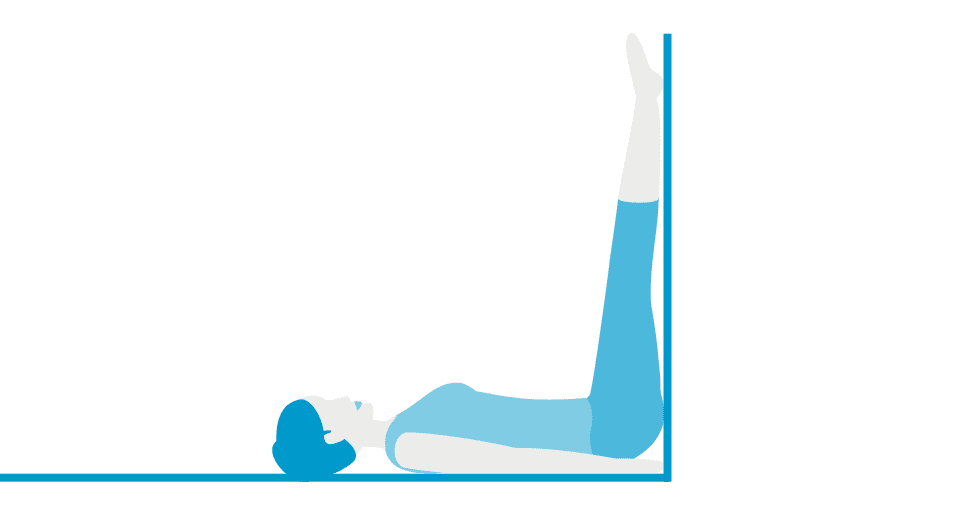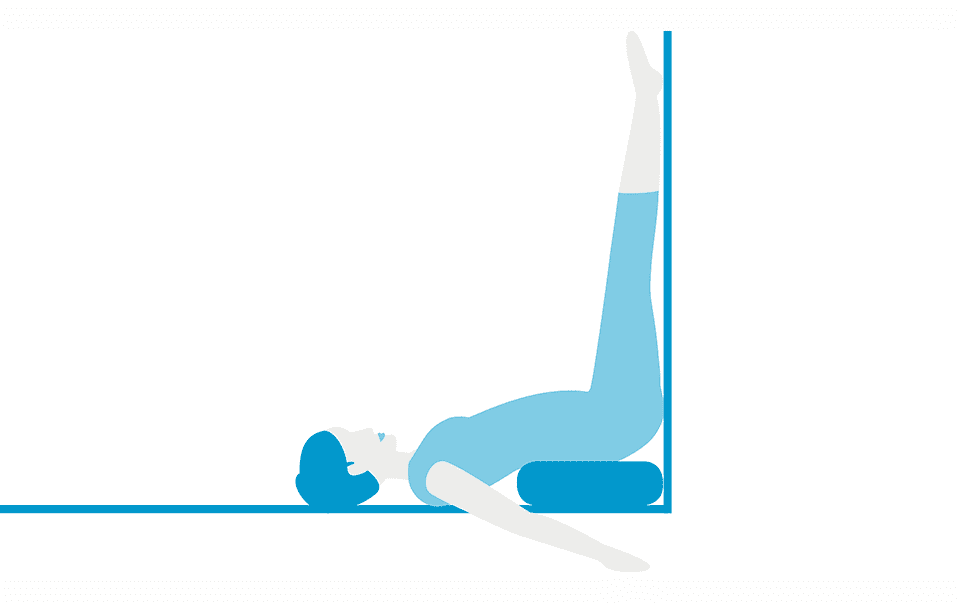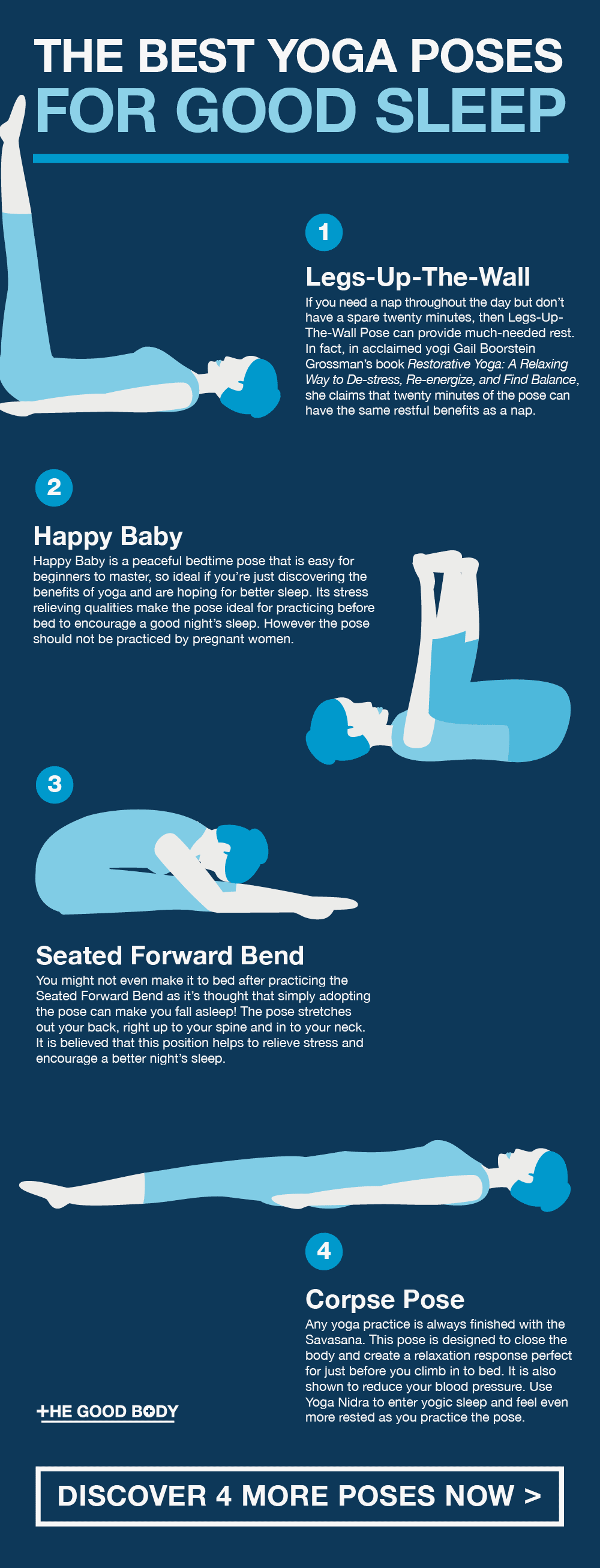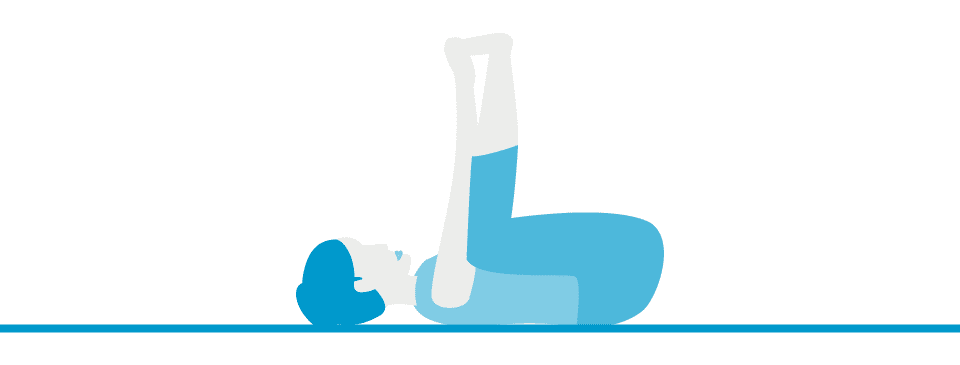Not only is yoga proven to help you fall asleep quicker, there are certain asanas that are known to induce and improve the quality of your slumber.
It’s just one of the many yoga benefits!
In this article we’ll explore the best poses for sleep, whether you’re a seasoned yogi or an eager beginner.
Guided by trusted experts and the latest research, we’ll help you bend and stretch your way to a better night’s rest.

1. Legs-Up-The-Wall (Viparita Karani)
If you need a nap throughout the day but don’t have a spare twenty minutes, then restorative yoga can provide a much-needed rest.
In fact, in acclaimed yogi Gail Boorstein Grossman’s book Restorative Yoga: A Relaxing Way to De-stress, Re-energize, and Find Balance, she claims that twenty minutes of legs-up-the-wall can have the same restful benefits as a nap.
Viparita karani can be practiced with or without a bolster.

The version with a bolster is ideal for those looking for asanas for back pain, as it makes it less impactful on your lower back.
It also allows your body to be at its most restful, so you can enjoy complete relaxation.
Judith Hanson Lasater, in her book Relax and Renew: Restful Yoga for Stressful Times, shows how the position is ideal for sleep problems, particularly for those with chronic insomnia.
She highlights how the movement with a bolster can help to restore balance within the body following overactivity, describing how it:
Relieves the systematic effects of insomnia… reduces fatigue, quietens the mind and refreshes the heart and lungs.
It should not be performed by those in the second or third trimesters of pregnancy and should be avoided during mensuration.[1]

Pin it for later!
Don’t forget to pin these poses for later!

2. Restorative Bridge (Setu Bandha Sarvangasana)
Backbends are known for their restorative value so why not add the bridge to your bedtime routine to help you drift off?
The restorative version is considered the best for inducing sleepiness, so use blankets and bolsters to support your body while practicing.
Charlotte Bell, author of Mindful Yoga, Mindful Life: A Guide for Everyday Practice, describes how it can help you enjoy the health advantages of restorative yoga especially during busy times.[2]
She looked at restorative asanas for sleep, in relation to those suffering from Seasonal Affective Disorder (SAD), particularly the associated feelings of fatigue.
The poses, including the restorative bridge, helped to renew energies and quieten the mind.
Users of the social networking site Quora, discussing yoga for sleep, repeatedly highlighted setu bandha sarvangasana.
They felt adopting the form at least 30 minutes before getting in bed was the key to success.
See here how to perform the exercise with a bolster:


3. Reclining Bound Angle (Supta Baddha Konasana)
This is another great nighttime posture.
Anything can be used as a prop, such as a blanket, towel, bolster, even a simple pile of (your favorite yoga) books can do the trick.
Cyndi Lee, author of May I Be Happy: A Memoir of Love, Yoga, and Changing My Mind, describes how the pose encourages the body’s “rest and digest” response.
It is thought that this response helps to reduce the heart rate and encourage a peaceful night’s rest.
In the aforementioned Relax and Renew book, Judith Hanson Lasater describes how the stance is powerful at reducing fatigue, especially if you’re struggling with insomnia.
It also has merits for women during menstruation.
That isn’t the end of the list of health advantages either!
The restful response it encourages can be a great relief for those hoping to find poses for anxiety.

4. Wide-Knee Child’s Pose (Balasana)
Practicing balasana as a part of your bedtime sequence allows you to unwind and release all your worries from the day.[3]
If a busy mind is keeping you awake this position can calm it, relax you and help you sleep like a baby!
Research published in the Journal of Clinical Oncology looked at how yoga could boost the sleep quality of cancer survivors.[4]
Participants followed the same program for four weeks – balasana was one of the postures in the sequence.
Improvements were seen in sleep quality, as well as wake after onset and efficiency.
There are a number of variations to this exercise, including the wide-knee version.
The goal is to be rested, so yogis suggest that anything that makes the movement more comfortable should be encouraged, such as placing a cushion or pad under your head so it’s not resting on the floor.
In his book A Journey into Yin Yoga, renowned practitioner Travis Eliot describes its power for sleep.
Focusing on child’s pose, he comments how it “activates the nervous system’s relaxation response”.
He does however advise caution if you’re suffering from tight hips or a knee injury.

5. Happy Baby (Ananda Balasana)
This peaceful bedtime asana is easy for beginners to master, so ideal if you’re desperate to get some shut-eye.
Straps are suggested initially if you struggle to reach your ankles, to make the exercise as comfortable as possible.
Mimicking a happy baby, yogis can hold their feet or ankles to create a form that offers full body relaxation.
Its stress relieving qualities make it ideal for practicing before bed. However it should not be practiced by pregnant women.
See the video below for how to perform the movement effectively:


6. Lizard (Utthan Pristhasana)
Lizard can be a challenging pose for beginners. However when mastered it can help you catch some serious Zs!
It encourages real focus on your breathing which opens up your hips and chest, preparing the body for other positions.[5]
Fitness experts at Holmes Place include utthan pristhasana in their guide to unlocking the power of sleep.[6]
They describe it as a versatile asana with plenty of health perks.
Looking to build muscle with strengthening yoga poses? This is one to add to your list!

7. Seated Forward Bend (Paschimottanasana)
You might not even make it to bed after practicing this bend as it’s thought that simply adopting the posture can make you fall asleep!
It stretches out your back, right up to your spine and into your neck.
A study published in 2017 focused on how yoga could improve the sleep quality of women with Type 2 diabetes.[7]
Comparing it with aerobic exercise (running on a treadmill), 39 diabetic women were recruited.
They followed a 12 week program which included this movement.
It was concluded that yoga is more effective in improving sleep and should be recommended as a treatment option for people with Type 2 diabetes.
Seated forward bend is best performed once the body is warmed up, why not incorporate it with other positions before bedtime?

8. Corpse Pose (Savasana)
Any session is always finished with the savasana. Designed to close your body, it creates a relaxation response perfect for just before you climb into bed.
It is also shown to reduce your blood pressure.
The simplicity of the motion means it can be practiced in bed, as long as you remove any bulky quilts or blankets so you’re lying on the flattest possible surface.
What about supercharging this pose by lying on an acupressure mat and reaping all the rewards of that too?
There are variations of the savasana to make it perfectly comfortable for you.
Cover yourself with a blanket for warmth or use a bolster under your knees if you’re struggling with back pain.

In the aforementioned A Journey into Yin Yoga, Travis explains how the position “cools the mind” and allows you to rest your body completely.
He also advises that this position shouldn’t be practiced by those in the later stages of pregnancy who are no longer able to fully recline.
Stretch out!
Once you’ve awoken fresh from your trip to dreamland, you might feel ready to start stretching again!
Become more supple and create a ‘healthier you’ by using these yoga poses for flexibility.
References
- Lee, C. (2010). Do Less, Relax More: Legs-up-the-Wall Pose [Online]. Yoga Journal. Available from: https://www.yogajournal.com/poses/legs-up-the-wall-pose [Accessed 14 July 2023]. ↩
- Penguin Random House (2023). Mindful Yoga, Mindful Life [Online]. Available from: https://www.penguinrandomhouse.com/books/551732/mindful-yoga-mindful-life-by-charlotte-bell-foreword-by-donna-farhi/ [Accessed 14 July 2023]. ↩
- EverydayYoga.com (2015). How to Do Child's Pose in Yoga [Online]. Available from: https://www.everydayyoga.com/blogs/guides/how-to-do-child_s-pose-in-yoga [Accessed 14 July 2023]. ↩
- Mustian, K.M. et al (2013). Multicenter, Randomized Controlled Trial of Yoga for Sleep Quality Among Cancer Survivors [Online]. Journal of Clinical Oncology. Available from: https://www.ncbi.nlm.nih.gov/pmc/articles/PMC3757292/ [Accessed 14 July 2023]. ↩
- Gaia (2016). Lizard Lunge: Utthan Pristhasana [Online]. Available from: https://www.gaia.com/article/lizard-pose-utthan-pristhasana [Accessed 14 July 2023]. ↩
- Holmes Place (2023). Sleep Better – Discover the Power of Sleep [Online]. Available from: https://promo.holmesplace.com/rs/410-RUY-740/images/HP_SleepBetter_Guide.pdf [Accessed 14 July 2023]. ↩
- Ebrahimi, M., Guilan-Nejad, T.N. and Pordanjani, A.F. (2017). Effect of yoga and aerobics exercise on sleep quality in women with Type 2 diabetes: a randomized controlled trial [Online]. Sleep Science. Available from: https://www.ncbi.nlm.nih.gov/pmc/articles/PMC5612039/ [Accessed 14 July 2023]. ↩




